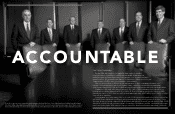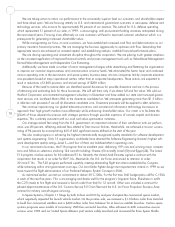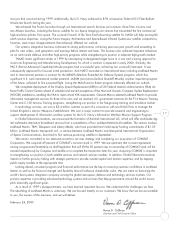Lockheed Martin 1999 Annual Report Download - page 18
Download and view the complete annual report
Please find page 18 of the 1999 Lockheed Martin annual report below. You can navigate through the pages in the report by either clicking on the pages listed below, or by using the keyword search tool below to find specific information within the annual report.
25
Lockheed Martin Corporation
satellite systems due to over-capacity of transponders in
some regional areas, and launch vehicle failures experi-
enced by the Corporation and its competitors during the
past two years. These issues have also resulted in delays
for commercial satellite orders, which are expected to con-
tinue into 2000. The Corporation has addressed issues
associated with prior failures of its Titan and Proton launch
vehicles, which have been returned to flight status. The
above factors related to reductions in launch vehicle orders
have resulted in pricing pressures due to increased com-
petition in the launch vehicle industry. The Corporation
has established cost objectives related to its launch vehicle
programs intended to allow it to continue to compete in this
market while maintaining its focus on successful launches,
though it cannot predict the outcome of these efforts.
In connection with expanding its portfolio of offered
products and services in commercial space and telecommu-
nications activities, the Corporation has entered into various
joint venture, teaming and other business arrangements,
including some with foreign partners. The conduct of interna-
tional business introduces other risks into the Corporation’s
operations, including fluctuating economic conditions, fluc-
tuations in relative currency values and the potential for
unanticipated cost increases and timing issues resulting from
the possible deterioration of political relations.
In 1992, the Corporation entered into a joint venture
with two Russian government-owned space firms to form
Lockheed-Khrunichev-Energia International, Inc. (LKEI).
Lockheed Martin owns 51 percent of LKEI and consolidates
the operations of LKEI into its financial statements. LKEI has
exclusive rights to market launches of commercial, non-
Russian-origin space payloads on the Proton rocket from a
launch site in Kazakhstan. In 1995, another joint venture
was formed, International Launch Services (ILS), with the
Corporation and LKEI each holding 50 percent ownership.
ILS was formed to market commercial Atlas and Proton
launch services worldwide. Contracts for Proton launch
services typically require substantial advances from the
customer in advance of launch, and a sizable percentage
of these advances are forwarded to Khrunichev State
Research and Production Space Center (Khrunichev), the
manufacturer in Russia, to provide for the manufacture
of the related launch vehicle. Significant portions of such
advances would be required to be refunded to each cus-
tomer if launch services were not successfully provided
within the contracted time frame. At December 31, 1999,
approximately $724 million related to launches not yet
provided was included in customer advances and amounts
in excess of costs incurred, and approximately $848
million of payments to Khrunichev for launches not yet
provided was included in inventories. Through year end
1999, launch services provided through LKEI and ILS
have been in accordance with contract terms.
An additional risk exists related to launch vehicle
services in Russia. Under a trade agreement in effect since
September 1993 between the United States and Russia, as
amended most recently in July 1999, the number of Russian
launches of U.S. built satellites into geosynchronous and
geosynchronous transfer orbit is limited to twenty from trade
agreement inception through the year 2000. Officials of
the U.S. Government have stated that this limit will not be
raised until Russia takes satisfactory action to resolve mis-
sile technology proliferation concerns. This limit, if not
raised or eliminated, could impair the Corporation’s ability
to achieve certain of its business objectives related to
launch services, satellite manufacture and telecommunica-
tions market penetration. At December 31, 1999, no
portion of customer advances was associated with launches
in excess of the quota, and approximately $245 million
of the $848 million of payments to Khrunichev disclosed
in the prior paragraph were associated with launches in
excess of the number currently allowed under the quota.
The Corporation determines amounts related to launches in
excess of the quota taking into account the number of
launches currently allowed under the quota (twenty at
December 31, 1999, as discussed above), and without
regard to the quota’s current expiration date of December 31,
2000. Management is working to achieve a favorable res-
olution to raise or eliminate the limitation on the number of
Russian launches covered by the quota.
The Corporation has entered into agreements with RD
AMROSS, a joint venture of the Pratt & Whitney division
of United Technologies Corporation and the Russian firm
NPO Energomash, for the development and purchase,
























